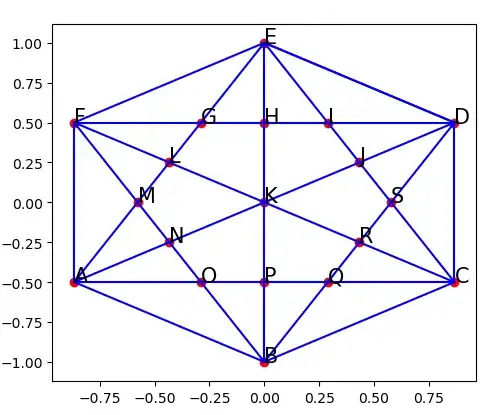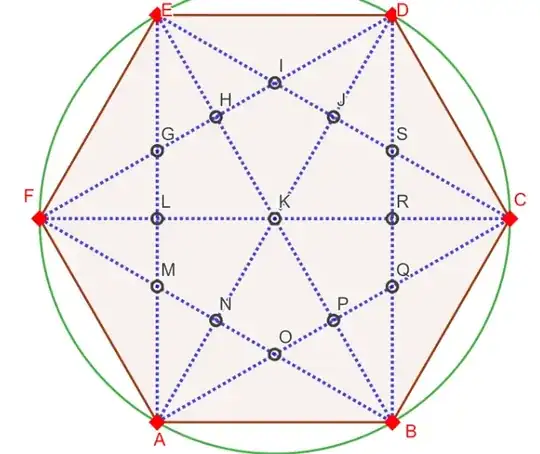I'm attempting to solve for one of the beavers, just to see if I've figured it out :)
All in all, it is a graph traversal problem which you can solve with backtracking. I believe that he problem is NP complete, so you'll need an algorithm to count them all. I have implemented the graph and a depth-first search algorithm in python. It turns out that I was underestimating very much!
- Beaver 1: A$\to$B gets 5 apples
- Beaver 2: A$\to$C gets 41 apples
- Beaver 3: A$\to$D gets 121 apples
Enjoy!
Python simulation
Import required packages
import numpy as np
Define the graph
nodes = {
"A": [-np.sqrt(3)/2, -1/2], "B": [0,-1], "C": [np.sqrt(3)/2, -1/2], "D": [np.sqrt(3)/2, 1/2], "E": [0,1],
"F": [-np.sqrt(3)/2, 1/2], "S": [1/np.sqrt(3),0], "J": [np.sqrt(3)/4, 1/4], "L": [-np.sqrt(3)/4, 1/4],
"I": [1/(2*np.sqrt(3)) , 1/2], "K": [-np.sqrt(3)/4 , 1/4], "G": [-1/(2*np.sqrt(3)), 1/2], "H": [0, 1/2],
"Q": [1/(2*np.sqrt(3)), -1/2], "N": [-np.sqrt(3)/4, -1/4], "M": [-1/np.sqrt(3),0], "P": [0, -1/2],
"R": [np.sqrt(3)/4, -1/4], "O": [-1/(2*np.sqrt(3)), -1/2], "K": [0,0],
}
edges = [
["A","B"], ["A","O"], ["A",'N'], ['A','M'], ['A','F'], ['B','O'],
['B','P'], ['B','Q'], ['B','C'], ['C','Q'], ['C','R'], ['C','S'],
['C','D'], ['D','E'], ['D','S'], ['D','J'], ['D','I'], ['D','E'],
['E','I'], ['E','H'], ['E','G'], ['E','F'], ['F','G'], ['F','L'],
['F','M'], ['M','N'], ['N','O'], ['O','P'], ['P','Q'], ['Q','R'],
['R','S'], ['S','J'], ['J','I'], ['I','H'], ['H','G'], ['G','L'],
['L','M'], ['K','R'], ['K','J'], ['K','H'], ['K','L'], ['K','N'],
['K','P'],
]
To test, here is a plot of the graph
for edge in edges:
ls = nodes[edge[0]]
le = nodes[edge[1]]
plt.plot([ls[0], le[0]], [ls[1],le[1]], color="blue")
for p in nodes:
l = nodes[p]
plt.text(l[0],l[1],p)
plt.scatter(l[0], l[1], color="red")

Auxiliary functions. The first one gets the other node in an edge; the second one computes the distance between two nodes.
def getOther(node, edge):
a,b = edge
if node == a:
return b
else:
return a
def getDistance(node1, node2):
x1,y1 = nodes[node1]
x2,y2 = nodes[node2]
return np.sqrt((x1 - x2)**2 + (y1- y2)**2)
Depth first graph search.
def getPaths(source, destination):
pathsout = []
stack = [source]
while stack:
path = stack.pop()
node = path[-1]
if node == destination:
pathsout.append(path)
dist = getDistance(node, destination)
candidates = [getOther(node, edge) for edge in edges if node in edge]
for c in candidates:
if getDistance(c, destination) <= dist:
stack.append(path + c )
return set(pathsout) # transform into set to remove duplicates
Run simulation
print(f"n. paths from A to B: {len(getPaths('A','B'))}")
print(f"n. paths from A to C: {len(getPaths('A','C'))}")
print(f"n. paths from A to D: {len(getPaths('A','D'))}")
Results:
# paths from A to B: 5
# paths from A to C: 41
# paths from A to D: 121
Paths
Print are the paths the beavers can follow
print(f"n. paths from A to B: {len(getPaths('A','B'))}")
print(' '.join(getPaths('A','B')) + '\n\n')
print(f"n. paths from A to C: {len(getPaths('A','C'))}")
print(' '.join(getPaths('A','C')) + '\n\n')
print(f"n. paths from A to D: {len(getPaths('A','D'))}")
print(' '.join(getPaths('A','D')))
Results:
n. paths from A to B: 5
AOPB ANOPB ANOB AOB AB
n. paths from A to C: 41
ANKJSC ANOPQC AOBPQC AOBQRC ANOBQRC AMNOPQC AMNKJSC AOPQRC ANOPQRC AMNKPQC AMNKJSRC AOBC AMNOBC ABPQRC AMNKPQRC AMLKRC AMNKRC ANOBQC AOBQC ANKRC AOPQC ABQC AMNOBQC AMLKJSC AMNOPQRC ANOBPQRC ANKJSRC AMLKPQC AMLKJSRC AMNOBQRC AMNOBPQC ANOBC ABC AOBPQRC ANKPQRC ANOBPQC ABPQC AMLKPQRC AMNOBPQRC ANKPQC ABQRC
n. paths from A to D: 121
AOPKHID ABOPKHID AMNKRSD ABONKHID AMLGHID AFGHID AFMLGEID AMNKHID AONKRSJD AFMLGHID AFMLKHIJD AFGEHID AOPQCRSJD AFLGEID ABONKRSJD AMLKHIJD ABONKJD ABPQCSJD AMLKJD AFMLKHID AFLKJD ABOPKHIJD ABQCSD ABCSD AMLKRSD AOPKRSJD ABCD AONKRSD AFMNKRSD AFLGEIJD ABPKRSJD AMLGEHIJD AFGED ABOPQRSJD ABQCSJD AOPQCRSD AFGEHIJD ANKHIJD ABOPKRSD AOPQRSD AFMLGEHID AMLGED AMNKRSJD ABQRSD AMLKHID AFMLKJD AFLGED ANKRSD AFLKHIJD AFMLGED AONKHID ABPKJD AMLGEIJD AFGHIJD AMLKRSJD AFLGEHID ABPKHIJD ABPQCRSJD AMLGEHID AFEIJD ABONKHIJD ABONKRSD ANKJD AOPKHIJD ABPQCRSD AFGEIJD AFEHID AMLGEID ABPQCSD ABPQCD ABQRSJD AMLGHIJD ABPKHID ABCRSD ABPQRSJD ABCRSJD ABQCRSJD ABOPQCSJD AFMLGEIJD ABOPKJD AMNKHIJD AONKHIJD AMNKJD AFEID AFLGHID AFLKRSJD ANKHID ANKRSJD AFMNKJD AFED ABQCRSD ABOPQCRSJD ABOPQRSD AOPKRSD AFGEID AFLGHIJD ABQCD AOPQCSD AFMLKRSD AONKJD AFEHIJD ABCSJD AFMNKHID ABPKRSD AOPQCD AOPKJD ABOPKRSJD AFMNKRSJD ABOPQCD AFMLKRSJD AFMLGEHIJD ABPQRSD AFLGEHIJD AFMNKHIJD ABOPQCRSD AFMLGHIJD AOPQRSJD AOPQCSJD AFLKHID ABOPQCSD AFLKRSD


Also, ANOB and ANOPB are invalid since N is closer to A than B. AOPB looks okay, as does AOPQB. This is all based on a shaky interpretation of the question though. Where does the question come from, by the way?
– saulspatz May 31 '19 at 12:29